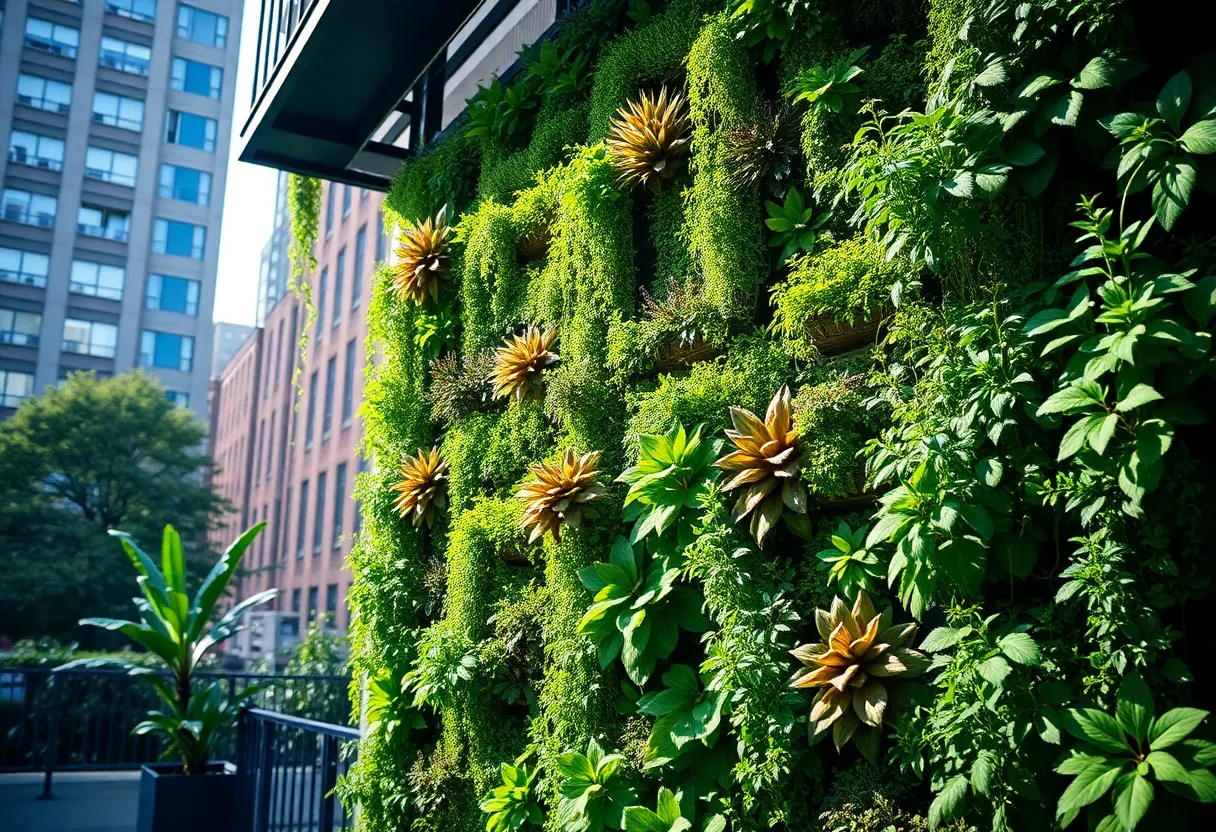7 Tips for Creating a Stunning Vertical Garden in New York’s Limited Spaces
Maximizing limited space in a dense urban environment requires innovative approaches. Vertical gardening addresses this challenge effectively, transforming vertical surfaces into functional green spaces. For residents in New York City—where traditional ground gardening is often unfeasible—vertical gardens provide an avenue for fresh produce, vibrant floral displays, and aesthetic improvement. Implementing a successful vertical garden hinges on understanding spatial constraints, plant selection, system design, and ongoing maintenance.
1. Assess Your Space and Sunlight Exposure
Beginning any vertical gardening project demands a thorough evaluation of the available area. This step is fundamental because plant health depends heavily on the natural environment. First, measure your spatial boundaries: determine the size, shape, and structural features of your wall, fence, balcony, or rooftop. Next, observe the sunlight patterns over different times of day and across seasons. NYC’s skyline creates varied shading, with high-rise shadows influencing sunlight availability. Many plants require 6-8 hours of direct sunlight daily, but shade-tolerant options are available for less exposed zones. Identifying the brightest and shaded spots allows you to match plants with their preferred light conditions. A precise assessment ensures that your plant choices will thrive and minimizes the risk of over- or under-exposure.
2. Choose the Right Vertical Gardening System
The selection of an appropriate system determines the success of your vertical garden. Factors influencing this choice include space constraints, aesthetic preferences, ease of installation, and water management. Consider these common systems:
Wall-Mounted Pocket Planters
Fabric or plastic pouches attach directly to walls or fences. They offer flexible placement for herbs, small vegetables, and flowers. These are lightweight, simple to install, and suitable for both indoor and outdoor environments.
Stackable Planter Systems
These are interlocking containers that build upward, forming towers ideal for small patios or balconies. Many incorporate self-watering features, facilitating consistent moisture levels and reducing maintenance.
Trellises and Climbing Supports
Using slender trellises or panels against walls allows vining plants—such as cucumbers, peas, and beans—to grow upward. This approach maximizes ground space and enhances visual interest.
Vertical Hydroponic Systems
Soil-free solutions circulate nutrient-rich water through multiple planting ports. These systems are especially suited for indoor spaces, providing high-density planting without traditional soil constraints.
Hanging Baskets
Suspended at staggered heights, baskets create visual movement and are effective for trailing plants, herbs, and small fruits like cherry tomatoes.
Repurposed Shoe Organizers
A budget-friendly option involves hanging clear organizers on walls or doors. Each pocket can host herbs, small vegetables, or flowers, optimizing up to 24 plants in minimal space.
Window Box Extensions
Designed to attach to window frames, these provide deeper soil beds for vegetables such as bush tomatoes and peppers. They are especially functional on north-facing windows, supporting shade-tolerant plants.
3. Select Suitable Plants for Vertical Gardening
Choosing the right plants underpins the success and visual appeal of your vertical garden. Prioritize plant varieties based on light exposure, growth habits, and edibility:
Annual Vines
Plants like black-eyed Susan vine, scarlet runner bean, moonflower, and cypress vine are lightweight, fast-growing, and thrive in full sun. They add color and texture to vertical spaces.
Perennial Vines
Options such as clematis, ivy, and American bittersweet are durable and lush. Many prefer full sun, but clematis benefits from shaded roots, offering design flexibility.
Shade-Tolerant Vines
Consider hardy kiwi, climbing hydrangea, Dutchman’s pipe, or chocolate vine for shaded areas. These plants adapt well to lower light levels and contribute greenery throughout the year.
Edible Plants
Vertical gardening can support food production. Suitable varieties include pole beans, climbing squash, cherry tomatoes, and herbs like basil, thyme, and mint. Use space-efficient vegetable crops to maximize harvests.
4. Implement Efficient Watering Techniques
Water management is critical for vertical gardens due to increased exposure and drainage considerations. Proper techniques prevent problems like overwatering, root rot, or drought stress:
Drip Irrigation
Installing a drip system ensures targeted, consistent watering directly to the roots, conserving water and reducing manual effort. It is especially effective for larger or multiple-tier setups.
Self-Watering Planters
These containers have reservoirs that automatically supply water as plants absorb it. They minimize water waste, prevent drying out, and extend intervals between manual watering.
Watering Schedule
Develop a regular routine based on plant needs, environmental conditions, and system capabilities. Regular checks help gauge moisture levels and adjust watering frequency accordingly.
5. Optimize Plant Maintenance
Long-term success relies on systematic care. Proper maintenance prevents pests, encourages growth, and sustains visual appeal:
Pruning
Remove dead or weak growth to promote airflow and prevent disease. Regular trimming encourages healthful new shoots, especially in vining plants.
Pest Control
Persistent vigilance for pests like aphids, spider mites, or caterpillars is necessary. Use integrated pest management strategies and natural deterrents to minimize chemical use.
Fertilization
Supply essential nutrients through balanced fertilizers tailored to plant types. Consider slow-release formulas or liquid feeds to support steady growth and flowering.
6. Incorporate Vertical Gardening into Your Lifestyle
A successful vertical garden integrates seamlessly into daily routines and living spaces:
Indoor Vertical Gardens
Wall-mounted planters or hydroponic systems inside spaces improve air quality, reduce noise, and add aesthetic value. Choose low-maintenance plants for indoor environments.
Rooftop Gardens
Transform rooftops with vertical systems to create green retreats. They offer privacy, scenic views, and temperature regulation benefits.
Community Gardens
Participate in or create shared green spaces where resources, tools, and knowledge are exchanged. This fosters community engagement and shared responsibility for urban greening.
7. Embrace Sustainability and Local Resources
Eco-friendly practices enhance the benefits of vertical gardening:
Composting
Recycle organic waste to produce nutrient-rich compost, reducing landfill contributions and enriching your soil or growing media.
Rainwater Harvesting
Capture rainwater for irrigation, conserving potable water and decreasing your environmental impact. Proper collection systems can be integrated into your setup.
Native Plants
Opt for native species suited to New York’s climate. These plants demand less water, fertilizer, and pest control, promoting sustainability and resilience.
Material Choices
Select environmentally friendly materials for constructing or modifying systems—using recycled, durable, and non-toxic components whenever possible.
Conclusion
Establishing a vertical garden in New York’s limited spaces involves careful planning, thoughtful plant and system selection, and diligent maintenance. By applying these strategic tips—assessing space, choosing appropriate systems, selecting suitable plants, managing water effectively, and incorporating sustainable practices—you can create a lush, functional green space. This transformation not only enhances aesthetics but also fosters environmental benefits and personal well-being within the constraints of urban living.
Author: STAFF HERE NEW YORK WRITER
The NEW YORK STAFF WRITER represents the experienced team at HERENewYork.com, your go-to source for actionable local news and information in New York, the five boroughs, and beyond. Specializing in "news you can use," we cover essential topics like product reviews for personal and business needs, local business directories, politics, real estate trends, neighborhood insights, and state news affecting the area—with deep expertise drawn from years of dedicated reporting and strong community input, including local press releases and business updates. We deliver top reporting on high-value events such as New York Fashion Week, Macy's Thanksgiving Day Parade, and Tribeca Film Festival. Our coverage extends to key organizations like the Greater New York Chamber of Commerce and United Way of New York, plus leading businesses in finance and media that power the local economy such as JPMorgan Chase, Goldman Sachs, and Bloomberg. As part of the broader HERE network, including HEREBuffalo.com, we provide comprehensive, credible insights into New York's dynamic landscape.





